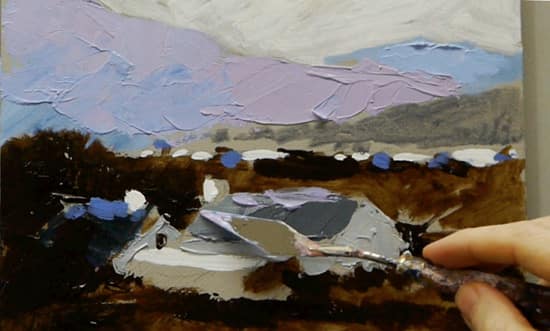
A step-by-step Palette Knife Acrylic Painting – Video Course Part 2
In this painterly, impressionistic palette knife study, I am posting a weekly video on my YouTube channel so that you can follow along at home.
It’s free to subscribe to the blog to receive updates so you can keep up with the painting progress.
The reference photograph and full material list can be found on Part 1 here.
The photo can be ‘right clicked’ and ‘Save image as’, so you can use it as a reference, print it out and follow along with the video below…
Part 2 of 4
So once we’ve established the darks using the Burnt Umber, and the lights using Titanium white, we can now start to build on these colours. The second stage is to introduce some blues into the painting.
This helps to create a visual balance between warm and cool, the browns being warm, the blues cool. Painting in this way can be very effective and a great way to discover how to mix neutrals.
Pro tip: Have a look at ‘Simple Still Life Tutorial Using Only 2 Colours’ for a painting completed using Burnt sienna, Ultramarine blue and Titanium white.
Common fears when using a palette knife
- It will break on me – I’ve never had a palette break or snap on me, the metal used has a great flex to it, so it is surprisingly resilient.
- Am I going to cut myself with the ‘knife’? – Not if you’re careful. If you use a painting knife with a rounded bottom it is very hard to cut yourself. I personally prefer the angled diamond shape for mixing and painting and if you use it daily, over a long period of time, the edge can become sharp.
Okay, I have to admit it, I have cut myself with a painting knife before, not whilst painting, but by cleaning. When you pull the knife through a piece of kitchen roll to remove the paint, just be careful not to pull the knife next to the palm of your hand. It wasn’t a bad cut, a bit like a paper cut, but it still smarts!
You can always use a plastic palette knife but I’ve found the lack of flex and spring makes for a less enjoyable painting experience.
Also, any flat surface can double as a palette knife, if you’re a keen baker you can find some lovely wide knives that can be used for large-scale work.
In my abstract paintings, which focused on the industrialization of the British landscape, I used tools from the building trade instead of a palette knife – trowels, plaster floats, I even tried a shovel!
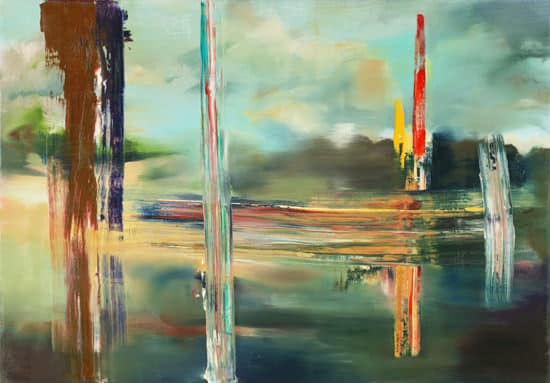
Will Kemp, If I could do it all over again, Oil on Canvas, 2002

These were quite large paintings (about 5ft by 4ft) and I initially painted a picturesque idyllic English scene, and then ‘blotted the landscape’ by dragging bright, vivid colours through the painting.
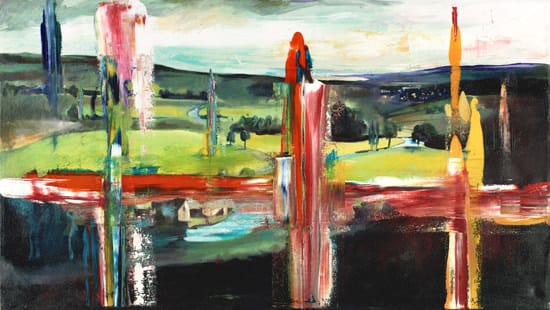
Will Kemp, Wait till the cows come home, Oil on Canvas, 2003

So don’t feel you have to use a specific tool, experiment to find what suits your own style of work.
Notice on the detail above how I even scratched into the paint using a palette knife to ‘draw’ a bridge. This technique is called Sgraffito and is most commonly used in pottery to make decorative patterns in the unfired clay, so go for it!
Large-scale knives don’t always have to to be used on large sale abstracts though. In my recent Venice paintings, (most of the paintings are painted with a brush) key thicker areas of paint were applied with the palette knife.
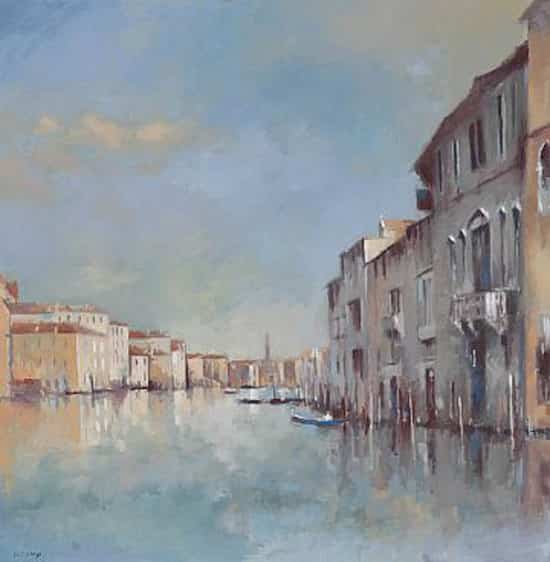
Will Kemp, Soft Waterways Venice I, Oil on Board, 24 x 24 inch, 2012

Will Kemp, Venice detail, Oil on Board, 24 x 24 inch, 2013
So let’s get started again on our palette knife study with the blues, and build up our painting in texture and colour.
How to paint with a palette knife – Free acrylic video Course |Part 2
This video below shows the next steps of this palette knife landscape tutorial.
ARVE Error: Invalid URL https://www.youtube.com/embed/uzV5ldPq2Ao in urlMake sure to subscribe (it’s free) to keep updated, you’ll get email updates when the next video is posted.
Next week, for Part 3, we’ll start to bring in some bright oranges to the foreground, so the cooler blues in the background mountains start to recede.
If you want to brush up on your colour theory, you should have a look at my Simple Colour Mixing Course.
You might also like:
1. Acrylic Palette Knife Painting Techniques – Free Video Course Part 1
2. Acrylic Palette Knife Painting Techniques – Free Video Course |Part 3
3. Acrylic Palette Knife Painting Techniques – Free Video Course |Part 4



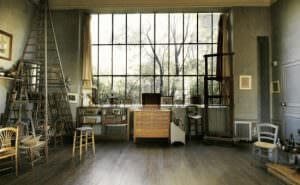

Dear Will, the end result is that you are master colorist painter if even you keep a palette knife or a tool or whatever else you use to paint, the word is Fantastic, harmonius, makes you travel away.
Hi Mary, thanks very much.
Cheers,
Will
Dear Will, Thanks loads for sharing your talent and inspiring so many of us. I enjoy viewing your highly instructive videos and reading your clear and concise articles on painting.
Hi Ransome, you’re welcome, great to hear you’re finding the tutorials clear and instructive.
Cheers,
Will
Thanks for this part 2 Will. Really getting a bead on how to loosen up and blend colours together.
Will have you ever used water mixable oil paints? If so are you pro or con?
Thanks again.
Hi Sherrill,
Glad you enjoyed part 2.
Water mixable oil paints can be a good place to start if you don’t want to use solvents when painting but want a longer working time (drying time) than acrylics.
As for brushes, with water mixable oils you want a brush that is a bit stiffer than a watercolour brushes but not quite as thick as a hog hair brush, due to longer exposure to water a brush with a mix of synthetic and natural bristles would work well. Winsor and newton have developed some brushes specifically with water mixable oil paints in mind that you might find useful, they are called ‘Artisan range of brushes.
I have used the water mixable Oils but found they didn’t have the pigment strength or quality that artist quality Oils have.
They do have the advantage of an easy clean up but lack the qualities of Oil paint I love so much.
Hope this helps,
Will
Hope this helps,
Dear Will
As a South African poor novice painter, I can’t thank you enough for your videos.
To-day I will start painting with a pallet knife. Fingers cross.
Good one Connie, enjoy it!
Will
Estimado Will: yo en óleo utilizo , blanco de zinc para las mesclas , el blanco de titaneo lo dejo para la etapa final, solo o con amarillo de nápoles por ejemplo porque noto que matea un poco mi pintura. En acrilicos opera igual? gracias
Dear Will: I use in oil, zinc white for mixtures, the target of titanium white, I leave for the final stage, alone or with naples yellow for example, because I notice that my painting mattes slightly. Does it work in acrylics like this ? thanks
Hola Angelica,
El uso de zinc blanco y negro para las mezclas de titanio para las fases finales en las pinturas de aceite es un buen enfoque – debido al tiempo de secado lento de blanco de titanio.
Todas las pinturas al óleo se mate, cuando se oxida petróleo.
Con acrílicos, titanio seca blancos en la misma proporción que cualquier otro color, por lo que se puede utilizar desde el primer momento.
Espero que esto ayude,
Will
Hi Angelica,
Using Zinc white for mixes and Titanium white for the final stages in oil paints is a good approach – due to the slow drying time of Titanium White.
All oil paintings will matte, when the oil oxidizes.
With acrylics, Titanium white dries at the same rate as every other colour, so can be used from the very start.
Hope this helps,
Will
Hi Will,
Thank you so much for this series! I’m new to your work, been painting for years but I feel like I’ve struck gold with your vibrant paintings as well as your easygoing teaching style. Much appreciated.
Hi Lisa, you’re welcome. Looking forward to hearing how your painting turns out.
Thanks,
Will
Hi Will, love the way you make the marks with the knife. The acrylic looks juicy, like oils. Two questions: What do you think of painting first in acrylics on canvas. Then using oil glazes over the top? Secondly, Do you prefer oils or acrylics?
Thanks for the generous sharing.
Hi Lesley, thanks for dropping by, painting oil glazes over acrylics can be okay, you just have to make sure the acrylic isn’t on too thick. Otherwise the oils don’t have a tooth to grab onto, so can make an unstable paint surface film.
I wouldn’t say I prefer one paint over the other, it really depends on the subject and the effect I’m trying to achieve with the painting, for example, I paint my portraits in oils due to the subtle skin tones I’m trying to create. For an expressive palette knife study acrylics would be the preferred choice.
Cheers,
Will
Just want to thank you Will for sharing your paintings with us. I absolutely love the colours you have used on your abstract paintings and I am amazed at the “tools” you have used and the size of the canvasses. It must take you so long to do paintings this size. I particularly like “wait till the cows come home” The way you have incorporated the beautiful , peaceful countryside with the industrial side. It is sad though to see what is happening to your beautiful country pastures etc and I can tell you it is happening over here in Australia as well. I was shocked a couple of weeks ago when we went for a drive into the country and we came across this massive building site in the middle of nowhere. All the land was being carved up for massive homes, roads everywhere etc etc and a small park in the middle of it!!!!. Your feelings really show through in your paintings Will thanks again. Isabel
Thanks Isabel, really pleased you appreciated the abstracts and their story.
Cheers,
Will
Hi Will,
I love the demos and all your articles. Hope to take a course with you soon.
Hi Mridula, thanks very much, great to hear you’re enjoying the tutorials.
Cheers,
Will
Dear Will, I started a message to you a few minutes ago and I either lost it while looking elsewhere on your site, or it went off before I finished it. I have no idea.!!!!! I wrote telling you that I am having trouble with my paints, when laying on the paint using my pallete knife the paint has no texture to it, it just lies flat . The consistency of the paints are like cream. I am new at using acryclics and I am wondering if our weather has anything to do with this. It is very hot over here at present, 38 degrees Celcius today and has been hot for days, could this affect them? I paint in our garage in the morning and evenings not in the hottest part of the day. The garage has no airconditioning. I keep them on a wet pallete (your video) and keep them in the fridge when not in use. I am also wondering if I am making the pallete too wet.! Would it be ok if I added some kind of medium to the paints to thicken them. When I used to use oils with a pallette knife the paint sat up nice and thick. I am using Atelier Interactive artists acrylics. I would appreciate some advice as I have no idea what to do. Sincerely Isabel
Hi Isabel,
The hot weather would dry the paints out more quickly, but not thin them out. I think the thinning of the paints is due to the stay-wet palette. If the stay-wet palette has a lot of water in it, overnight the water that’s held in the ‘blotting paper’ section of the palette will be sucked up by the acrylic overnight and thin the paint mixture down.
If the paints are in the palette for a day or two then the acrylics could have easily become more cream like in consistency. Try using some paint straight from the tube and see if it holds the shape.
If you are still having trouble you can mix in a heavy gel that will add stiffness to the paint.
Cheers,
Will
Thank you very much Will. The paint had been on the palette overnight but I think I will try a gel as I also tried the paint straight out of the tube. I will let you know how I get on.
Cheers, Isabel
You’re welcome Isabel, let me know how you get on with the gel.
Thanks,
Will
Thank you for these splendid videos. I am trying to do knife work over an unfinished painting of blossom against sky (done with a brush and Golden liquid acrylics). It was dull and I thought a knife treatment would liven it up. It has become a mess! And now of course there are ridges everywhere and can’t be painted over. I guess I will have to ditch it. Can you offer guidelines on subjects/sizes that are unsuitable for knife work please. I am particularly keen on flowers but not landscapes!
Hi Jill, thanks for dropping by, sorry to hear the blossom painting didn’t liven up as intended. In terms of subject matter, any subjects will work with palette knife painting, from portraits, flowers to still lifes. It’s just a balancing act depending on tne level of detail/size of canvas you’re working on.
Will
Thanks for the reply Will. I will consider the size of marks more before rushing in too enthusiastically next time. A lesson learned I hope! By the way, where and when is this next exhibition of yours?
Hi Jill, yes, the scale of canvas can make a big difference when working with palette knives. The exhibition was a private exhibition through my publisher that was held this past weekend, first news back and the paintings have sold really well!
Cheers,
Will
Hello Will,
Thank you so much for your very clear, simple to follow, down-to-earth and inspiring tuts, which allows all us painters out here to keep up with your demonstrations. So often, mistakes and corrections are left out, which mostly leaves beginners feeling rather inadequate, so I find your way of teaching very refreshing.
I generally paint in oils over an underpainting of acrylics. Very seldom do I complete a painting in acrylics because I find the way I handle acrylics leaves my paintings flat and chalky. They lack the layered depth and luminosity achievable from oils. I’ve never tried any of the mediums available and wondered if any of them will help, or if I should simply change my paint application.
I’m currently working on an acrylic painting for the ‘everyone counts’ campaign, and have again managed to achieve my too chalky look. I would really appreciate some advice.
Much appreciated,
Suraya
Hi Suraya, thanks for your kind comments, really pleased you’re finding the tutorials and videos helpful in your painting.
To answer your question:
They lack the layered depth and luminosity achievable from oils. I’ve never tried any of the mediums available and wondered if any of them will help, or if I should simply change my paint application.
The luminosity you see in oil paints is the actual oil that is used to bind the dry pigment. The longer the oil has to dry the more matte the surface will become, you will often see this is a painting where an area of oil painting is matte which is called ‘sinking in’ it is most noticeable in blacks.
Different brands of acrylics dry to a different level of gloss or matte. For example, New Masters from Old Holland have been developed to dry with a semi-gloss finish.
To achieve the gloss effect on your acrylics you just need to apply a layer of varnish that either has a gloss of semi-gloss finish. You first need to apply an isolation coat ( which will be gloss) then you can judge if you like that level of finish and continue with a gloss varnish or semi-gloss varnish ontop.
The isloation coat means the varnish can be removed and re-applied in the future without disturbing the paint surface.
So you don’t need to change your paint application, just the finish to your acrylic paintings.
Hope this helps,
Will
Is it possible to use palette knife on paper?
Yes it is possible, try using a palette knife with a rounded edge to help prevent accidentally cutting through the paper. Numbers 26 and 13 from the RGM line would be a good choice.
Cheers,
Will
Hi Will,
The trouble i faced while trying a random landscape in acrylic medium is the line is defined at the junction of sky and mountains and water.. By the time I would try work on the sky and then water the junction line of sky would get defined and not merge…I don’t get much time to paint every day so every time I refuse I get stuck in merging the junctions… Kindly guide…
Also the abstract painting you have posted above are d one in oil paints… Can they be done in acrylic??
Hi Neha,
Acrylics would dry too quickly for the technique if you’re coming back the next day to the painting. Have you tried working with oils?
Will
Hello Will-
I can’t tell you how much I have learned and grown from watching your videos! About a year ago, I knew nothing, except what I learned at one of those “Wine and Paint at the Pub” classes (where I ruined a pic with that horrible green!). Anyhow, you are a wonderful teacher and you really have a gift! Painting has brought me so much joy and relaxation in a stressful world and I try to paint what I know I’ll really love.
Anyhow…. I am going to go buy a palette knife this week and try something new again. I think I need new shades, so I may invest in a tube of something plum to make decent purples. Do you have a favorite one I should try? Right now I only have a tube of crimson red and can’t get those lovely purples in your “Monet” painting.
Thanks, Will!
Monica
Hi Monica, thanks your kind words about the videos on the site. So pleased that they helped with your painting education! A nice plum colour is Cobalt Violet (Hue) , but it can be hard to track down some brands, other nice purples are Dioxazine Purple (more blue) or Quinacridone Magenta – thinner but lovely for glazes. You can see what can be achieved with different reds and blues from this purple mixing video I made,
Hope this helps,
Will
I was very interesting in your work and tried to imagine how you use your extraordinery knowledge and I have been founding it is as I expect
what master as it could be
I would be happy if you make new course about composition and
how colours and their warms or cools we would use in our work so
that our paintings would see nice for eyes and be best balanced.
You can show as more of yours works , they are very inspirative
Thanks Will Vanessa
Thanks Svetlana, hope you’re enjoying the course.
Will